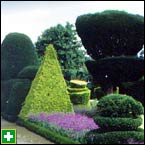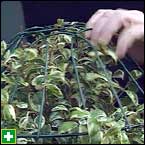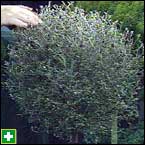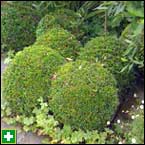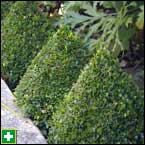Tips for topiaryTopiary is all about time and patience, and is by no means a brutal process. Maggie Barry tries her hand at this ancient art. The key to good topiary lies in accuracy, precision and patience. Rome wasn't built in a day, and neither is the art of topiary. The best way to shape a plant like this (Buxus sempervirens) is by eye — and, most importantly, to take your time. Stand back, take a look and it, and if in doubt don't cut off too much. If you end up cutting into old wood, you'll have made it very difficult for yourself to keep up the appearance. Do this once or twice a year and you should have achieved the desired effect in a couple of years. I also have a juniper that is growing in a spiral shape. This isn't easy to do and is an extremely long and time-consuming process, which is why plants like this juniper are so expensive. 'Swane's Gold' naturally grows in a column shape so will lend itself well to a spiral. To get started, tie a piece of string around the very bottom of the trunk and loop it around the tree in a spiral shape. Then, using good, sharp clippers, cut up and around the string line. This process must be extremely accurate or the overall effect won't be achieved. Eugenia are very easy to keep shapely. The best way to get a nicely rounded tip is to get a hanging basket, turn it upside down and snip around it. If you want to maintain a nice trimmed look, you'd probably have to do this about five times in the growing season. There are a host of native plants that make fantastic topiary subjects. Characteristics that make for good topiary are small leaves and lots of branches, and they must be easy to grow. When it comes to topiary, natives are a lot more forgiving than conifers. If you do accidentally cut through old wood or brutalise them in some other way, they will bounce back eventually. The Coprosma "Lawrie Metcalf" (named after one of our most famous native plantsmen) is another great candidate. It can be cut to almost any shape, will grow up to 1.5 meters and can also be grown as a hedge plant. It's extremely easy to grow — all it needs is good drainage and full sunlight. Remember, plants that are constantly being cut back need to have their nourishment replenished, so a dose of fertiliser once a year wouldn't go amiss. For something with a bit of height to provide some more interest in the garden, the Coprosma virescens is the way to go. This is a tangly plant with all its leaves on the inside. You can let it grow naturally for an elegant, billowy effect or you can clip it for a more formal "blobby" shape. The Metrosideros 'Tahiti' is a close relative of the pohutukawa and is usually grown as a ground cover, but if you come across a specimen with a good strong centre stalk, stake it well and grow it as a standard. Clip it tight or let it weep gracefully; it's nice to have flowering plants in the garden for seasonal variation. Podocarpus acutifolius is a lot like a miniature totara. It is very responsive to clipping and can be grown as a standard or a hedge. Whichever plant you chose, remember the key to good topiary — patience. Happy cutting!
|
Home | Journal
| Newsletter | Conferences
Awards | Join
RNZIH | RNZIH Directory | Links
© 2000–2025 Royal New Zealand Institute of Horticulture
Last updated: June 2, 2004


